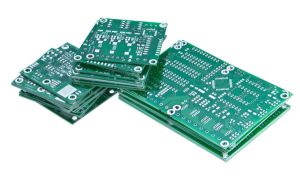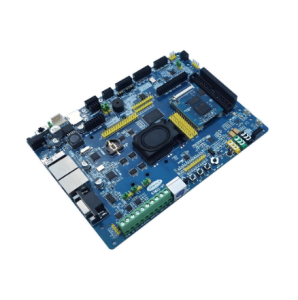Printed Circuit Boards (PCBs) are the backbone of modern electronics. They serve as the foundation for electronic components, providing connectivity and structural support. Whether you’re a hobbyist, engineer, or business looking to manufacture electronics, understanding the basics of PCB circuit boards is essential. In this guide, we will explore the fundamentals of PCBs, their types, materials, and applications to help you make informed decisions when working with them.
What is a PCB Circuit Board?
A Printed Circuit Board (PCB) is a flat board made of non-conductive material, typically fiberglass or plastic, on which conductive copper traces are etched. These copper traces act as electrical connections between components such as resistors, capacitors, transistors, and microchips. PCBs are used to mechanically support and electrically connect these components, forming a complete electronic circuit.
PCBs come in various sizes and complexities, from single-layer boards used in simple devices to multi-layer boards that are found in more advanced applications like computers, smartphones, and industrial machines. The versatility of PCBs makes them an essential part of any electronic device.

FR4 Multilayer PCB Manufacturer
Types of PCB Circuit Boards
PCBs come in different types depending on the number of layers and their specific applications. Here are the most common types of PCBs:
1. Single-Sided PCBs
A single-sided PCB has a single layer of conductive material on one side of the board. These boards are the most basic type of PCB and are used for simple electronics where the circuit doesn’t require complex routing or high-speed performance. Examples include calculators, LED lighting systems, and power supplies.
2. Double-Sided PCBs
Double-sided PCBs have conductive layers on both sides of the board, allowing for more complex circuits and better component placement. They are commonly used in more sophisticated electronics like amplifiers, industrial control systems, and automotive electronics. The additional layer allows for greater flexibility in circuit design.
3. Multi-Layer PCBs
Multi-layer PCBs have three or more conductive layers, separated by insulating materials. These boards are used in high-performance electronics such as computers, medical devices, and telecommunications equipment. The multiple layers allow for complex circuit routing and reduce the size of the device by fitting more circuits into a smaller space.
4. Rigid, Flex, and Rigid-Flex PCBs
PCBs can also be categorized based on their flexibility:
Rigid PCBs: These are the most common type and are made from rigid, solid materials like fiberglass. They are used in applications where the board must maintain a fixed shape, such as computers and televisions.
Flex PCBs: Flexible PCBs are made from flexible materials, allowing them to bend and fold. They are ideal for applications where space is limited, such as wearable devices and cameras.
Rigid-Flex PCBs: A combination of both rigid and flexible PCBs, these boards provide the best of both worlds. They are used in complex devices that require flexibility and rigidity in different areas, such as smartphones and aerospace systems.
Materials Used in PCB Manufacturing
The choice of materials for a PCB depends on its application, cost, and performance requirements. Common materials used include:
Fiberglass (FR4): The most common material for PCBs, FR4 offers good insulation, mechanical strength, and moisture resistance. It’s used in most consumer electronics and industrial applications.
Polyimide: A flexible material used in flex and rigid-flex PCBs. Polyimide offers high-temperature resistance and durability, making it suitable for demanding environments like aerospace and automotive electronics.
Metal: Some PCBs use metal substrates such as aluminum to enhance heat dissipation. These boards are used in high-power applications like LED lighting and power converters.
Applications of PCB Circuit Boards
PCBs are used in virtually every electronic device. Common applications include:
Consumer Electronics: Smartphones, laptops, tablets, and other personal devices rely on PCBs to function.
Automotive: Modern vehicles use PCBs in everything from engine control units to entertainment systems and sensors.
Medical Devices: PCBs are used in medical equipment like MRI machines, pacemakers, and diagnostic tools due to their precision and reliability.
Telecommunications: PCBs are integral to the functioning of communication equipment, including routers, cell towers, and fiber-optic networks.
Industrial Equipment: PCBs are found in industrial control systems, automation equipment, and heavy machinery for monitoring and controlling operations.
Frequently Asked Questions about PCB Circuit Boards
What is the most common material for PCBs?
Fiberglass (FR4) is the most common material for PCBs due to its affordability, durability, and excellent insulation properties.
How many layers can a PCB have?
PCBs can have as many layers as required, but common multi-layer boards have between 4 and 12 layers. Advanced applications can have even more layers for complex circuits.
What are flexible PCBs used for?
Flexible PCBs are used in applications where space is tight or where the board needs to be able to bend, such as in wearable devices, cameras, and certain medical equipment.
Conclusion
Understanding PCB circuit boards is critical for anyone working with electronics. From single-sided boards to complex multi-layer systems, PCBs power the devices that drive our modern world. With various materials, types, and applications, PCBs offer unparalleled versatility for designing efficient and compact electronic circuits. By selecting the right PCB type and material, you can ensure optimal performance for your specific application.

